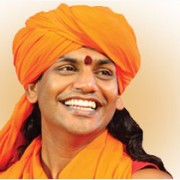The Nithya Yoga practice is a beautifully structured sixty minute class that includes most traditional yogic practices including postures (asana), breath control techniques (pranayama), stylised hand gestures (mudras), relaxation, rejuvination (shivasana) and deep meditation (dhyana).
A typical class comprises of nine guidelines that essentially help us experience the space of nithya yoga, eternal uniting, moment to moment, every moment. They include:
Centering Meditation
a. PatanjaliDhyaan – Students walk into the class and centre themselves by intense movement of every part of the body, loosening of the muscles, removing lethargy and restlessness of the body-mind. This simple technique brings intense awareness and helps the student to be totally and completely anchored in the body.
b. Breath Awareness – Next, sitting in a comfortable posture, students bring their awareness to the breath. Just watching the breath anchors the mind deeply within. The frequency of thoughts reduces dramatically and it becomes easy to set the intention for the session.
________________________________________
Intention
In Nithya Yoga we believe a strong, conscious intention or sankalpa stated positively brings with it the energy to fulfil it. So the students are encouraged to set the intention for the class with depth and clarity.
________________________________________
Visualization
Once the intention is set, students are asked to move their body with a deep visualisation of the intention so that it can be recorded and stored in the muscle memory. Then, when the body and breath are moved with awareness they empower the bio-energy to absorb the visualisation and make it a physical reality. In Nithya Yoga we operate from the truth stated by ParamahamsaNithyananda, ‘With whatever intention you move your body, it is that intention that gets inscribed in the muscle memory’. Adequate importance is given to the setting of the intention and the visualisation process.
________________________________________
Asanas or Postures
Next comes the practice of asanas or physical postures. As the student moves into a vinyasakrama (the intelligent positioning of postures that flow into one another) the emphasis is on moving the body and breath with awareness to awaken the potential energy and the innermost intelligence present in every cell of the body. Students experience a deep cleansing, healing and rejuvination as the physical and psychological toxins get washed away from the system.
Different sets of asana are done to experience flexibility and energy. These asana are always done in unison with the breath so that the effect of each is intensified.
One such default vinyasakrama is the suryanamaskar or sun salutation. It comes either in the beginning of anasana practice session, as a deep warm up for more advanced postures, or it in itself is a prime vinyasa.
The suryanamaskar is a practice that cannot be reduced to a physical movement that stretches, limbers, tones and strengthens the entire body and spine. It is a complete spiritual practice (sadhana) on its own. It is an expression of gratitude to the sun outside of oneself; however, in a deeper sense, suryanamaskar is a practice that enables one to recognize one’s own inner sun. Surya namaskar will awaken the body intelligence to directly create energy from the sun. It works on all body parts, every organ, every system and every chakra (energy center). A daily practice of a complete set of twelve repetitions of suryanamaskar along with the respective mantra chant is enough to reap enormous benefits at the level of body-mind-spirit. It is aptly described as the king of asana.
________________________________________
Pranayama or Breathing Technique
With the body awakened through the asana practice, students are ready to go deeper with the breath. Here the students need to understand that when we practice pranayama, we are not only taking in oxygen but also taking inprana. Prana is cosmic intelligence; it is life force energy. We prepare the lungs through different breathing techniques so we can receive more and more pranashakti inside of us. The pranashakti comes in through the oxygen. When we take in more oxygen, we essentially take in more pranashakti. Consequently, strength and vitality is increased, the nervous system is calmed and the body and mind are relaxed for meditation to happen.
________________________________________
Shivasana – Body Gratitude Relaxation
Once nithya yoga is over, students lie down to offer gratitude to each and every part of the body, starting from the toes and moving progressively upward to the crown of the head.
No, we haven’t made a mistake using the word ‘shivasana’ instead of ‘shavasana’ (corpse pose). When we relax our body with complete awareness and gratitude, we move into a space of deep healing and rejuvenation. Shava means corpse and Shiva means rejuvenation.
Therefore in Nithya Yoga we do shivasana. Truth be told, shivasana is essentially the most important aspect of the entire practice where our body is preparted to receive the deep understanding of its true nature, bliss at all levels – physical, mental, emotional, and spiritual. our body can relax, heal and rejuvinate.
________________________________________
Affirmation
Students are guided to turn to the side and sit up. Then the affirmation, ‘I am intensely and completely radiating nithyananda, eternal bliss’ is stated with a deep conviction.
________________________________________
Conclusion
We finish the class by chanting ‘Poorna Mantra and Om Nithyanandam’. The meaning of this chant is: ‘may you be in a state of eternal bliss, which is your very nature’.
At the end of the class, students are reminded about who they truly are. It is this reminder, this essence that is carried by the student throughout the day, to lead the life of a jeevanmukta or living enlightenment.

